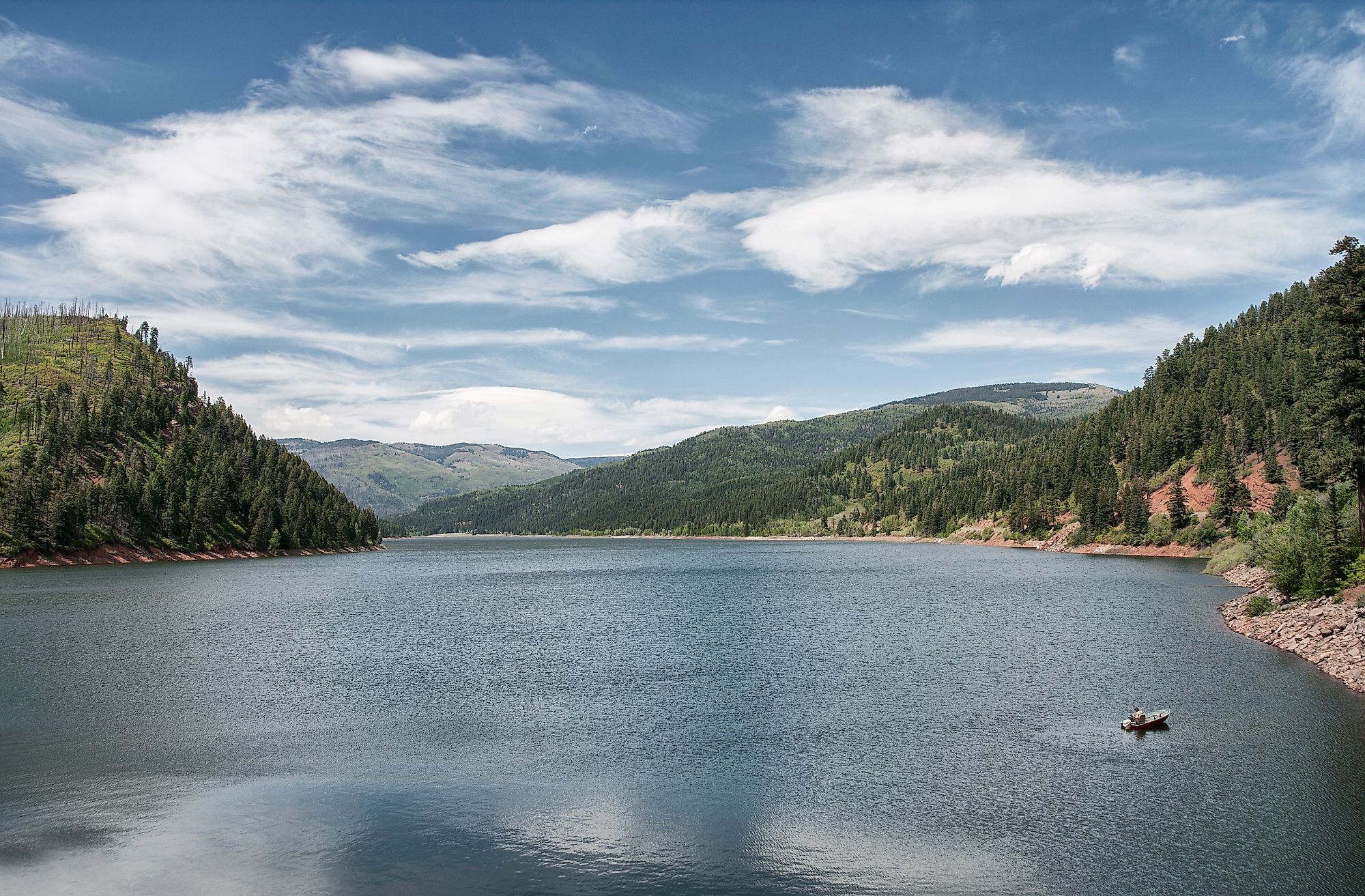
7 Most Beautiful Lakes In New Mexico
Nicknamed “The Land of Enchantment,” New Mexico is one of the Mountain States located in the American Southwest. The state is known for its highly varied geography featuring wooded mountains, verdant grasslands, plateaus, canyons, deserts, and many protected wilderness areas. New Mexico is also home to many major river systems and sizeable water bodies, including natural lakes and man-made reservoirs. These many bodies of water appear like a beautiful oasis in the surrounding desert landscape and serve as popular year-round vacation destinations attracting residents and tourists alike. So, those looking for a waterside escape can visit these lakes for a weekend or a vacation trip and relax along the shores of the lake amidst serene natural surroundings.
Abiquiu Lake
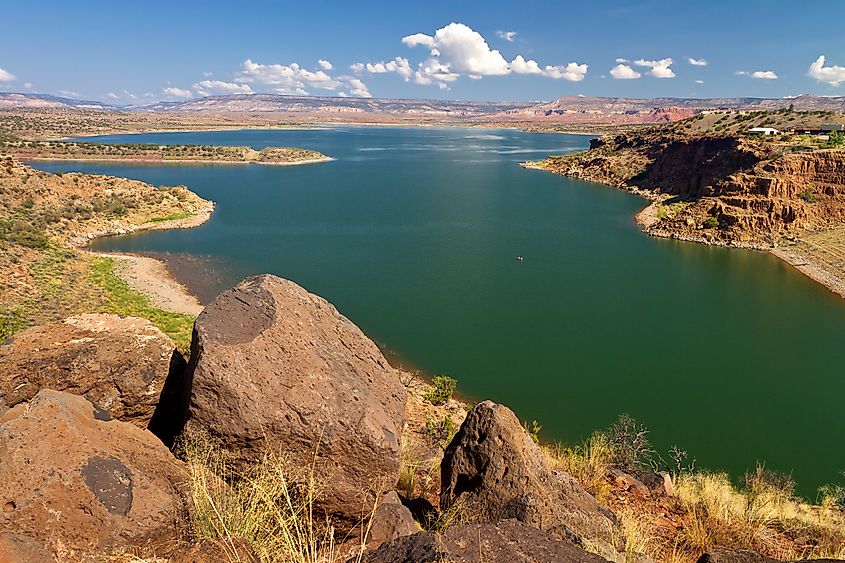
Formed by the construction of the 340 ft high Abiquiu Dam on the Rio Chama River, this flood-control reservoir is situated in Rio Arriba County in the northern part of New Mexico. Placed between the Sangre de Cristo and San Juan Mountain range at elevations between 6,100 to 6,220 ft, the Abiquiu Lake covers a surface area of 5,200 acres and reaches a maximum length of about 12 miles. From the Abiquiu Dam, one can get a beautiful panoramic view of the nearby “Cerro Pedernal” (Flint Mountain). Likewise, when seen from Pedernal’s summit, the Abiquiu Lake appears as a “brilliant blue opal” in a striking contrast with its high desert surroundings.
Abiquiu Lake offers some of the finest fishing opportunities in northern New Mexico, and many notable fish species like walleye, bluegill, catfish, smallmouth bass, crappie, and trout are found here. The US Army Corps of Engineers manages a recreation area close to the lake’s shoreline, where visitors can enjoy an array of recreational opportunities like boating, camping, fishing, hiking, mountain biking, wildlife watching, picnicking, and swimming.
Caballo Lake
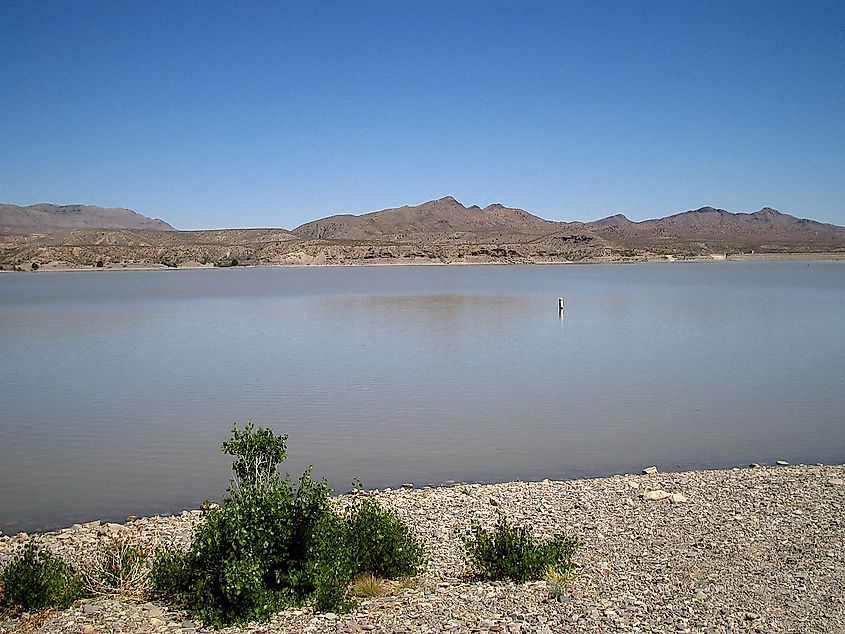
Created by the construction of the Caballo Dam on the Rio Grande River, this reservoir is located in Caballo Lake State Park, about 16 miles south of Truth or Consequences in southern New Mexico. The reservoir covers a surface area of 11,000 acres and holds a water volume of 347,000 acre-ft, making it the state’s fourth-largest reservoir in terms of surface area and the fifth-largest water body in terms of volume. Named after the majestic Caballo Mountains that surround it on the eastern, northeastern, and southeastern sides in which wild horses once roamed, Caballo Lake reaches an average depth of 23 ft and about 75 ft at its deepest point.
Caballo Lake is a reputed birdwatching site and quite popular among birdwatchers. The diverse habitats ranging from open waters to riparian woodlands shaded by cottonwoods, attract several avian species, including water birds, flycatchers, woodpeckers, migrating warblers, waterfowls, and occasionally bald eagles. Many fish species, like bluegill, catfish, walleye, crappie, largemouth bass, etc, are also found here. In addition, Caballo Lake State Park offers many recreational activities like fishing, camping, swimming, canoeing, boating, kayaking, and water skiing.
Conchas Lake
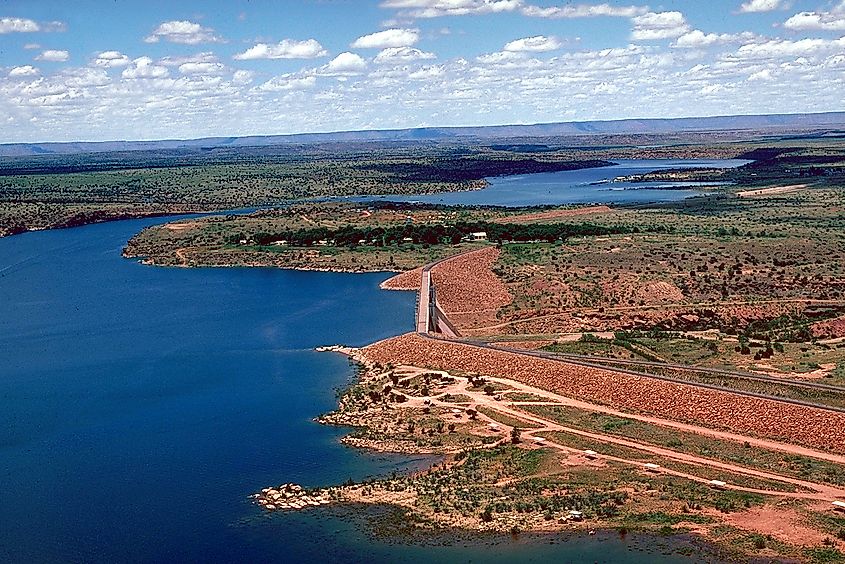
Formed by the construction of the Conchas Dam on the Canadian River, this 9,600-acre reservoir is located adjacent to the Conchas Lake State Park in northeastern New Mexico. Placed at an elevation of 4,200 ft, the reservoir has a maximum length of 25 miles and holds a water volume of 709,119 acre-ft. Conchas Lake can be reached via the 106.9-mile-long New Mexico State Road 104 at mile marker 75, located about 75 miles southeast of Las Vegas and 29 miles northwest of Tucumcari.
Several fish species like walleye, white bass, flathead catfish, bluegill, largemouth bass, shad, channel catfish, and crappie. The Conchas Lake State Park, located adjacent to the lake, is divided into north and south areas. The state park contains a total of 9 public boat ramps, of which five are in the north area and four in the south area. The Conchas Lake also features a number of secluded coves, canyons, and sandy beaches that offers a variety of water sport activities like fishing, camping, water skiing, and boating.
Elephant Butte Reservoir
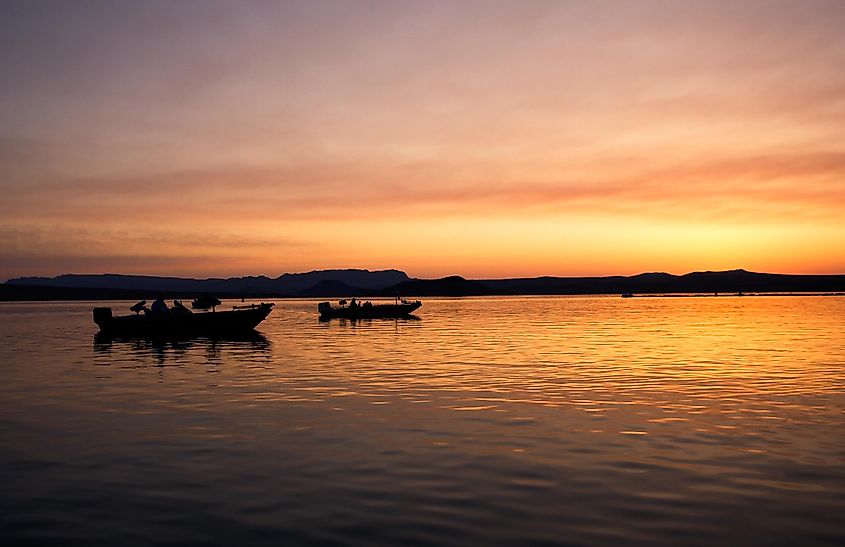
This 36,500-acre reservoir was formed by the construction of the Elephant Butte Dam on the southern portion of the Rio Grande River, about 5 miles north of Truth or Consequences in southern New Mexico. The reservoir is located in the state’s most expansive state park – the Elephant Butte Lake State Park, and is considered the country’s 84th biggest artificial lake as well as the state’s biggest lake in terms of total surface area and peak volume. Created as a part of the Rio Grande Project, the Elephant Butte Reservoir holds a water volume of 2,065,010 acre-ft and provides power and irrigation to the state’s south-central region and parts of Western Texas.
The reservoir, dam, and the surrounding state park have been named after an elephant-shaped remnant of an ancient volcanic core, “Elephant Butte,” which, at present, forms an island in the lake immediately opposite the dam. The reservoir supports a variety of fish species, like striped bass, largemouth bass, walleye, white bass, crappie, and catfish. The state park is a popular vacation destination for residents and tourists alike, offering plenty of recreational opportunities like fishing, camping, boating, water skiing, canoeing, swimming, and scuba diving.
Fenton Lake
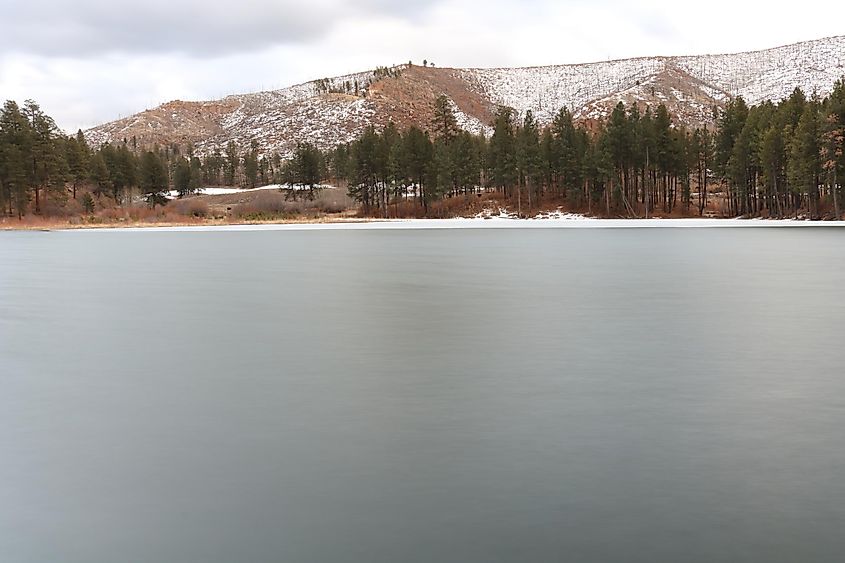
This 37-acre scenic mountain lake is located in the Fenton Lake State Park, about 33 miles north of the village of San Ysidro in New Mexico’s Sandoval County. Surrounded by beautiful ponderosa pine forests, the picturesque Jemez Mountains provide a stunning backdrop for this year-round retreat. Stocked with various fish species like rainbow trout, German brown trout, northern pike, walleye, etc., Fenton Lake offers excellent fly fishing and winter ice-fishing opportunities, making it a popular fishing destination. The Fenton Lake State Park also offers cross-country skiing, camping, picnicking, fishing, horseback riding, and boating.
Heron Lake
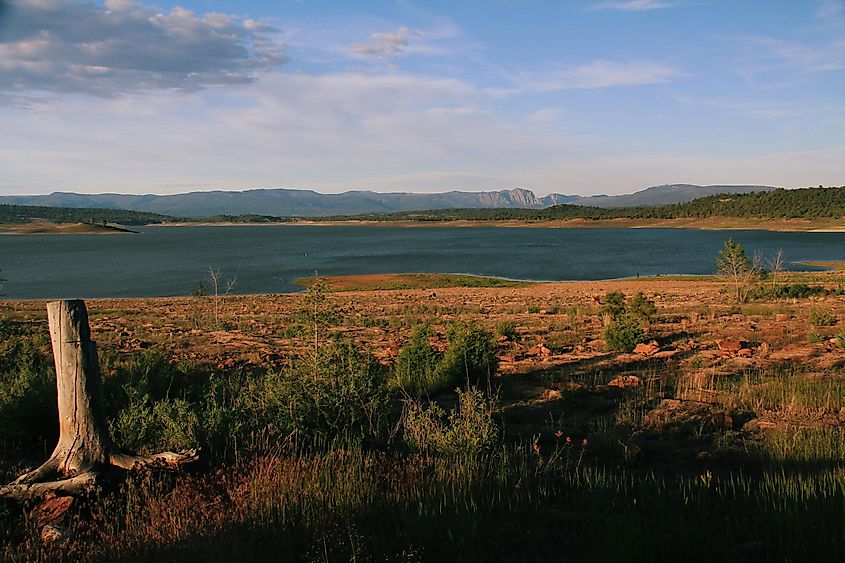
Located approximately 80 miles northwest of Santa Fe, this 5,900-acre storage reservoir was created by the construction of the 263 ft high Heron Dam in New Mexico’s Rio Arriba County. The reservoir forms a part of the San Juan-Chama Project, which links Colorado’s San Juan River with the Rio Chama River, a major tributary of the Rio Grande River. Placed at an elevation of 7,186 ft, Heron Lake has a maximum length of about 4 miles, a maximum width of 3 miles, and holds a water volume of 401,000 acre-ft.
The lake’s southern shores are home to Heron Lake State Park, which features more than 200 camping and picnic sites, boat ramps, hiking trails, and fishing points. The reservoir, dam, and the surrounding state park have been named in honor of Kenneth A. Heron, an engineer who envisioned the diversion of water from the Colorado River to southern New Mexico’s arid regions.
Navajo Lake
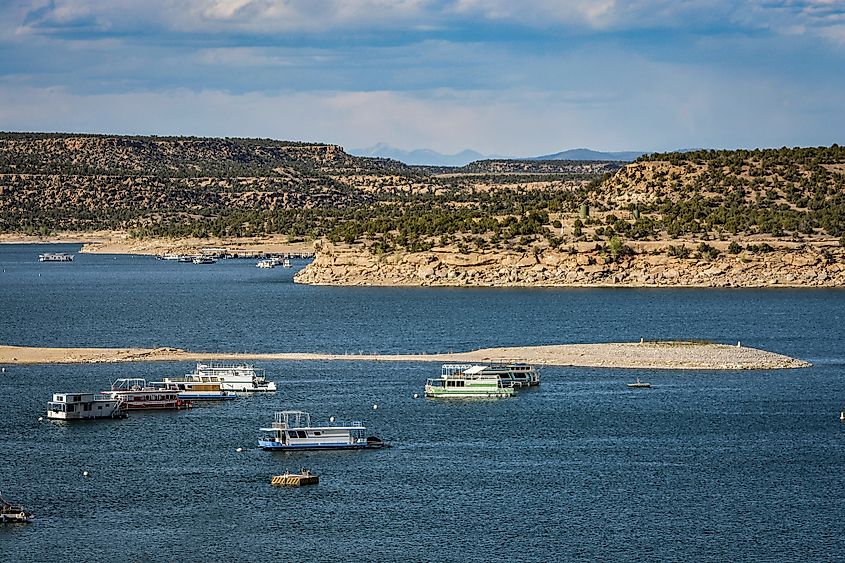
This 15,600-acre lake was created by the construction of the 400ft high Navajo Dam on the San Juan River in northwestern New Mexico as a part of the Colorado River Storage Project. Placed at a surface elevation of 6,035 ft, the lake has a length of more than 25 miles and holds a water volume of 1,708,600 acre-ft. The lake and its linked shoreline areas close to the dam as well as the river shorelines below the dam, form a part of the Navajo Lake State Park. The part of the lake which extends into southern Colorado’s Archuleta County forms a part of the Navajo State Park. The Navajo Lake is home to several fish species like smallmouth bass, northern pike, trout, channel catfish, and black crappie. The Navajo Lake State Park offers several campgrounds, marinas, boat docks, day-use areas, and serene hiking trails.
The above-mentioned 7 lakes are some of the most picturesque water bodies in the United States’ 5th largest and 36th most populous state. Each of these crystal-clear lakes has its own attractive charm and offers visitors breathtaking vistas and an array of year-round outdoor recreational activities for them to enjoy. So, whenever you get a chance to visit this Mountain State, do not forget to include these spectacular lakes in your itineraries and visit them to spend a fun-filled quality time with your loved ones.










